
Madeira Grape Varieties
The grape variety indicated on the label does not only name the grape that the wine was made from, but also indicates a certain taste. There is the dry Sercial, the mild Verdelho, the medium sweet Bual and the rich and oily Malmsey. Terrantez and Bastardo are usually medium dry but difficult to obtain these days since very little is grown on the island. If one of the before mentioned grapes is mentioned on the label, the contents have to be at least 85% of this variety. The Tinta Negra Mole, a red grape, is not mentioned on the label and can have tastes from dry to sweet, depending on the elaboration of the wine.
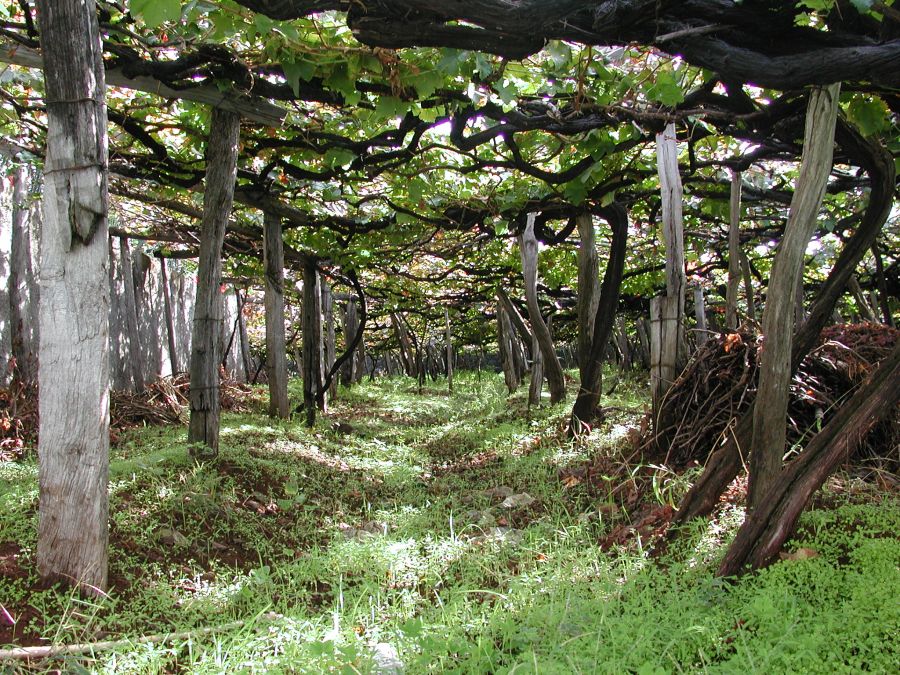
Vineyards in Estreito de Camara de Lobos
Just until a few years ago there were noble and good varieties, but today you speak of traditional varieties. These are: Sercial, Verdelho, Boal or Bual, Malvasia or Malmsey, Terrantez and Bastardo. Moscatel, Listrão and others are also called traditional. Officially the grapes are classified as “recommended” (like the Sercial, Verdelho, Boal, Malvasia, Terrantez, Bastardo, Tinta Negra Mole) and “authorized” (like the Moscatel, Listrao, Complexa, Triunfo and others).
The Commission Regulation (EEC) No 3369/92 of 24 November 1992 amending for the thirteenth time Regulation (EEC) No 3800/81 determining the classification of vine varieties specifies this issue exactly: Recommended vine varieties for Madeira are: Bastardo T, Boal B, Esgana Cao B (=Sercial), Folgasao B (=Terrantez), Malvasia Cândida B, Malvasia Roxa R, Moscatel B, Tinta T, Tinta Negra Mole T, Verdelho Branco B, Verdelho Tinto T. Authorized vine varieties for Madeira are: Água Santa T, Alvarinho Lilás B, Arns Burguer B, Bastardo Espanhol T, Cabernet Sauvignon T, Campanário B, Caracol B, Carao de Moça B, Chardonnay B, Chenin B, Complexa T, Deliciosa T, Ferral T, Generosa B, Grenache T, Listrao Roxo R, Malvasia Babosa B, Malvasia Bianca B, Malvasia Branca de S. Jorge B, Malvasia Cândida Romana B, Malvasia de Oeiras B, Malvasia Fina B, Malvasia Rei B, Mario Feld T, Merlot T, Mindelo T, Perigo B, Pinot Branco B, Pinot Gris R, Portalegre T, Riesling B, Rio Grande B, Sauvignon blanc B, Spatburgunder T, Syrah T, Tália B, Tinta Barroca T, Tinta de Lisboa T, Tinta do Porto Santo T, Touriga Francesa T, Touriga Nacional T, Triunfo T, Valveirinho B.
All the above-mentioned grapes are European varieties from the Vitis Vinifera family. Most of the lesser grapes, planted after Oidium and Phylloxera are from the American Vitis Labrusca or Vitis Aestivaldis family. Their main members are: Jacquez, Herbemont, Isabella, Othello and Noah. A simple table wine is produced from these grapes and sold on the island only, since the European Community does not allow export of wines from Vitis Labrusca. The strawberry-like taste or so-called fox-taste makes the distinction to the real Madeira wine made from Vitis Vinifera very easy.
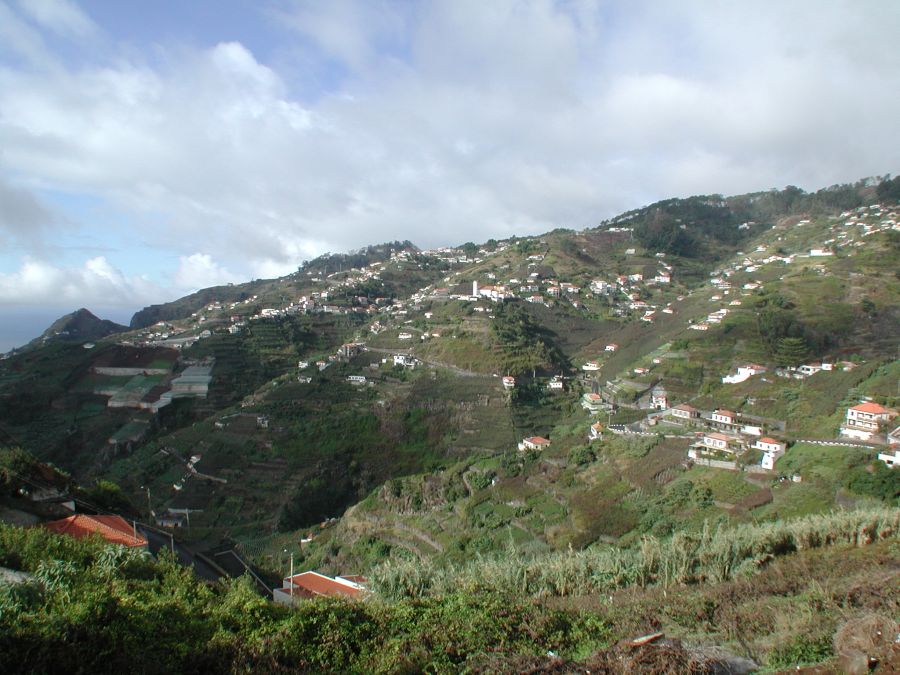
Vineyard in Estreito de Camara de Lobos
Sercial
The English name Sercial is used for the Portuguese Cerceal, but the grape used on the island of Madeira is not to be confused with the Cerceal do Dao. Sercial was not grown very much after Phylloxera, but the number of vineyards with Sercial is growing again. They are the vineyards with the highest altitude, situated in Seixal and Ribeira da Janela on the northern coast of the island. Some people say that because of the high level of acidity Sercial is the same grape as the German Riesling, but this is certainly wrong from an ampelographic point of view.
The grapes are very compact, about 18cm long, weighing 170grams. This variety ripens late, producing a wine with volatile fruit and good, sometimes burning acidity. The medium-size leaves have a hairy undersurface and are made of three main parts in the middle with one smaller part to each side.
The high level of acidity makes Sercial almost undrinkable in its youth. In the 16th century, this wine was called "Esgana Cão" - dog-strangler. To obtain a maximum aroma as a counterpart, Sercial is harvested as the last of the grapes, often as late as the beginning of October. Sercial has to mature for a long time, before it is drinkable. The minimum of twenty years in cask for vintages will just be enough to soften the piercing acidity. Once this wine has found its balance, it makes a perfect aperitif but it can also hold its own very well. On the island, Sercial is often served with soup, nuts, crackers or other snacks. The cocktail "Madeira on the Rocks" is made of 2/3 dry Madeira of a lesser quality and 1/3 Campari. Sercial also goes well after Champagne.
A vintage Sercial wine usually has a color of a golden tawny, similar to old German Riesling wines. The nose might display some high volatile acidity. Young Sercials often have a range of fruit aromas with a focus on orange and lemon, but as the wine matures this can shift to a more nutty and turpentine like taste, again similar to old Rieslings. A high level of acidity will be present in most Sercials, which will make this wine a good before-dinner drink. Also I prefer it after a meal to cleanse the palate.
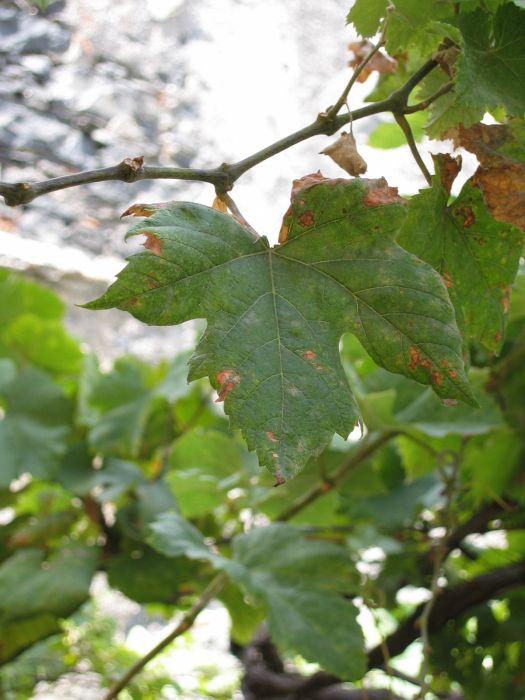
Sercial grapes seen at ABSL, shown with the friendly permission of Maik Göbel
Verdelho
Verdelho is also a white grape, the taste being medium dry, tasting between Sercial and Bual. Just like the other Castas Nobres it was very little grown until 1980, when it began being planted again. Verdelho, also known as Gouveio in Portugal, gives a medium dry wine. The grape is also cultivated in Australia. There also is a red variety of Verdelho, the Verdelho Tinto. Verdelho is grown on the south side of the island from Funchal west to Estreito de Câmara de Lobos. On the north side it is grown in the more sheltering pergola style in Ribeira de Janela and São Vicente.
The grapes are larger than Sercial, about 20cm long. They are good table grapes and give a mild wine with slightly nutty flavor, becoming drier as it matures. The vine is very strong and relatively high and difficult to cultivate. The leaves are of medium size with small hairs on both surfaces.
Verdelho is the main ingredient of a medium dry light wine called "Rainwater" which is very popular in the United States. The cheaper qualities are made from Tinta Negra Mole. The legend around the name tells that the contents of a shipment to Savannah, Georgia, were diluted when a heavy rain hit the casks still standing on the beach. The recipient of the shipment liked the lighter taste and ordered more. Verdelho is also used to make the Atlantis White, one of the two official table wines made on the island.
The color of Verdelho is about the same of Sercial, sometimes a little darker. It does not have the piercing acidity of Sercial but displays a more rounded taste. The nose has dried fruits and honey that are also evident on the palate and sometimes there are also a little coffee and chocolate.
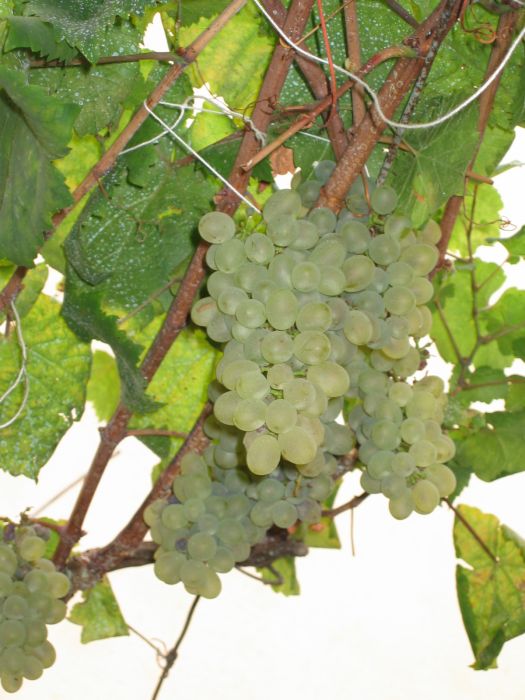
Verdelho grapes seen at ABSL, shown with the friendly permission of Maik Göbe
Bual
Bual is the English name for the Portuguese Boal. Bual is a white variety producing a medium sweet wine. The name was used for a whole group of grapes but today is usually connected with the Bual de Madeira also known as Boal Cachudo. Grown on the north side around São Vicente and on the south side at Campanário and Câmara de Lobos, it took over for Malmsey in many vineyards.
The grapes are large, heavy and are good table grapes because of their sweet aroma. The medium sized vine has three-part leaves like the Sercial.
Bual is a good start for those having their first experience with Madeira wine. It is medium sweet but not to sticky, very aromatic with some acidity balancing the sweetness. Do not let yourself be fooled by the color which tends to be the darkest of all Madeira wines. The nose has richness and aromas of barley sugar and the palate often has some additional caramel and coffee aromas as well as dried fruits like orange peel or apricot.
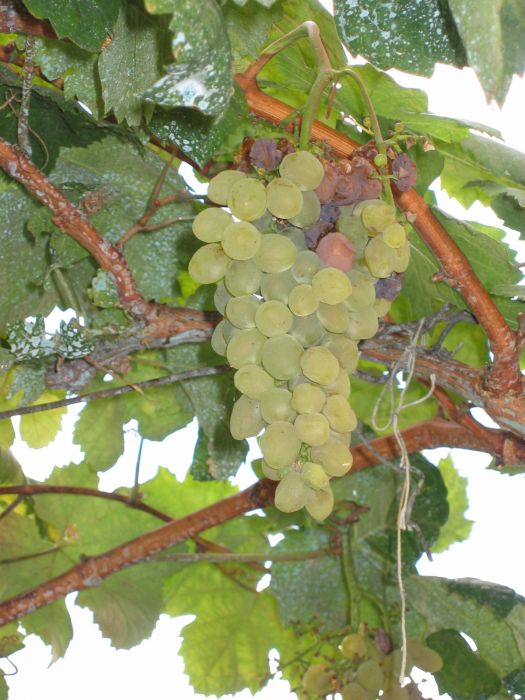
Boal grapes seen at ABSL, shown with the friendly permission of Maik Göbel
Malmsey
Malmsey is the most famous Madeira wine for sure. The English name Malmsey is used for the white Malvasia grape which has its roots in the Greek islands. Malvasia, or more precise, Malvasia Candida spread throughout Europe during the Middle Ages and went down in numbers in the Baroque period. However, around the world sweet and fortified wines are still made from all sorts of different members of the Malvasia family, like the white Malvasia Bianchi di Chianti, Malvasia Toscana, Malvasia Istriana, Malvasia delle Lipari, Malvasia Sarda, Malvasia di Schierano, Malvasia Candida, Malvasia Rei, Malvasia Bianca and the greek Malvazia as well as from the red Malvasia Nera and Malvasia di Carsorzo.
The large grapes with small elliptic berries weigh up to 400 grams and are grown on high and solid vines. The grapes are liked for their sweet aroma as table grapes. The variety ripens fast but can stay on the vine for a long time as they do not easily rot. The vineyards are the lowest in altitude, about 250 m above sea level. The grapes are grown in São Jorge and Santana on the north coast and in Câmara de Lobos and Estreito de Câmara de Lobos on the south coast. The leaves are made of five parts equal in size.
There are many stories around Malmsey which was exported as early as the 15th century. On the European continent the widely grown Malvasia of the Middle Ages had already found many friends like Martin Luther and minnesinger Oswald von Wolkenstein. In times when sugar was not known, this golden and sweet liquid sun fascinated the people. When later the more robust Madeira Malmsey entered the market, it was a complete success. It combined sweetness and aroma with good keeping and easy handling like no other wine.
In 1478 the Duke of Clarence preferred death by drowning himself in a cask of Malmsey to the death by sword. In the works of William Shakespeare's you can find many hints to Malmsey. In "Henry IV" Poins accuses the Prince of Wales to have sold his soul for a glass of Malmsey and a chicken leg. One of John Falstaff’s drinking friends is named after his Malmsey-reddened nose. Even Napoleon, stopping over on the island on his way into exile on St. Helena in 1815, took some Malmsey to brighten his days. Before, on his military operations, he had also carried some Malmsey with him. In the 19th century Malmsey really came en vogue. There was the "Morning Malmsey" to begin the day and many other rituals revolving around the golden wine. Even today, long after Oidium and Phylloxera, a good Malmsey crowns a perfect meal like no other wine. It also makes a good vino da meditazione. The combination with coffee, cookies or nuts is classical, as is the taste together with a very good bitter chocolate. But also on its own, Malmsey itself is an excellent desert. António Batalha Reis said: An elixir to be drunken by the gods, no drink for mere mortals! Even Goethe used to sip on his Malmsey, sitting in the cellar of the famous „Elephant“ hotel in Weimar.
An old Malmsey vintage will just be a little lighter in color than Bual. The nose is all toffee, vanilla and sometimes even beef bouillon. The palate has toffee and vanilla as well, added by marmalade sweetness and -some say- a distinctive taste of cough syrup.
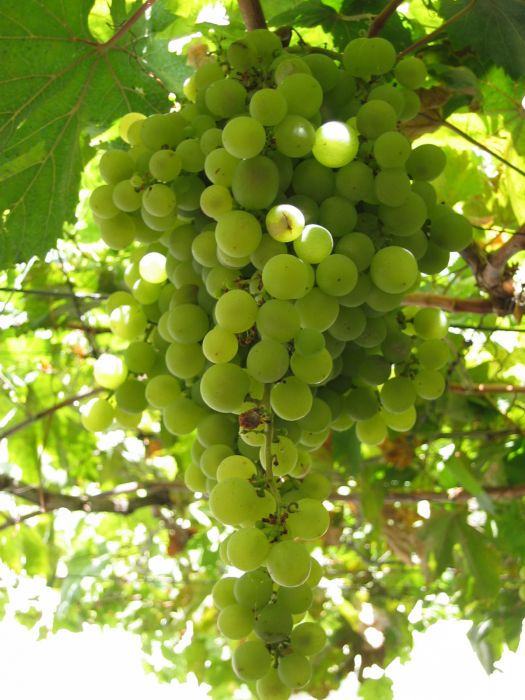
Malvasia grapes seen at ABSL, shown with the friendly permission of Maik Göbel
Terrantez
This white, medium dry, sometimes rather sweet variety is hardly grown anymore. You can sometimes still find it in old vintages or soleras. Unfortunately the total harvest of Terrantez does not even fill a complete cask of wine, usually containing a little above 500 liters. Efforts are underway to replant this grape, but since it is difficult to work with and yields rather low quantities, the growers are not very enthusiastic about replanting it. The Terrantez vintage wines mainly come in two different styles. One style is on the rich and rather sweet side, as used by the Madeira Wine Company. The other style is very dry, still rich though, a little like a rich Sercial, but without the strong lemon flavor. A characteristic of Terrantez is a certain bitterness at the end of the finish that reminds me of burnt coffee and ashes. A Portuguese proverb says "As uvas de Terrantez, não as comas nem as dês, para vinho Deus as fez." meaning: The grapes of Terrantez are not for eating, nor to give them away, but for wine god created them.
The Terrantez grape is my favorite variety for Madeira wine, because with this particular grape, Madeira wine seems to be at its best. Examples like the Acciaioly 1802 or the Blandy 1846 show the enormous potential of the grape, the caleidoscope of aromas and the ability to gain in complexity over the centuries.
Bastardo
This variety is still widely grown in Portugal and is identically with the French Trousseau. It is also a grape in the Douro valley used for Port. It is the only red grape among the Castas Nobres and nowadays you can only find it in old vintages and soleras. To my knowledge only miniscule amounts are grown these days. But some glorious old vintages do exist and of course there is the vintage of 1927 which produced excellent Bastardo wines. Even though Bastardo is a sweet grape, the style of the vintage wines is often on the dry side. It also has some bitterness at the end of the finish.
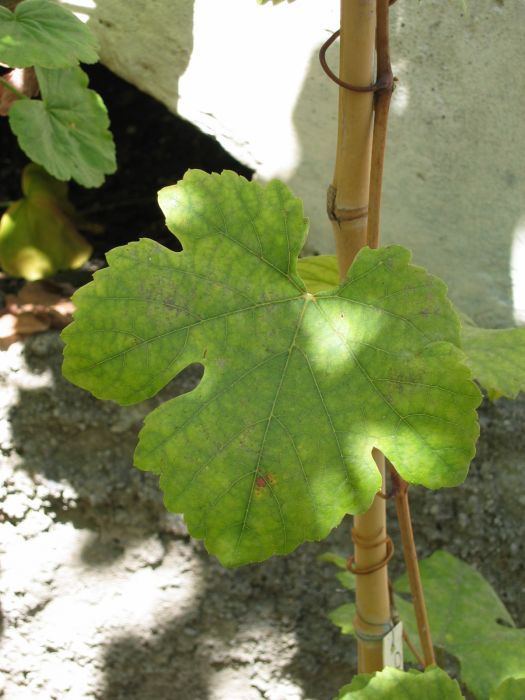
Bastardo grapes seen at ABSL, shown with the friendly permission of Maik Göbel
Moscatel
Moscatel is the white wine of the Moscatel of Alexandria grape, one of the lower quality varieties of the Muscat/Moscatel family, counted among the castas boas. It is apparently no longer grown in significant quantities, but you can still find it in some old vintages. Pereira D´Oliveira has a few different Moscatel vintages and some vintages of other producers are still around at auctions from time to time.
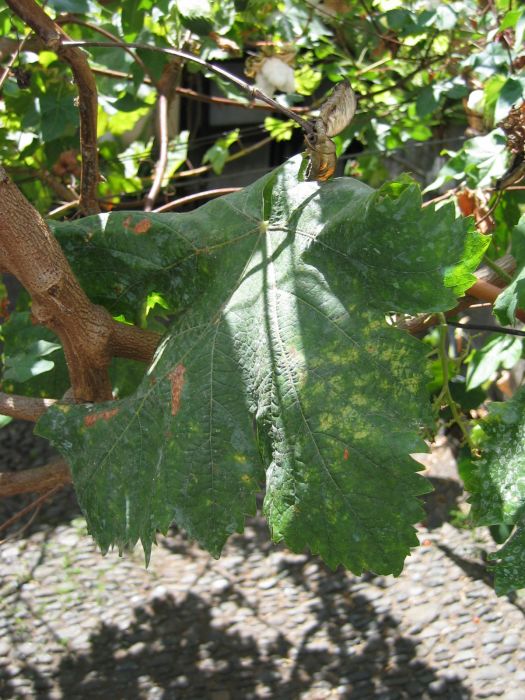
Moscatel grapes seen at ABSL, shown with the friendly permission of Maik Göbel
Listrão
Listrão is one of the authorized varieties for Madeira wine and is cultivated in small quantities on the neighboring island of Porto Santo. Barros e Sousa makes a five year old fruity wine of Listrão.
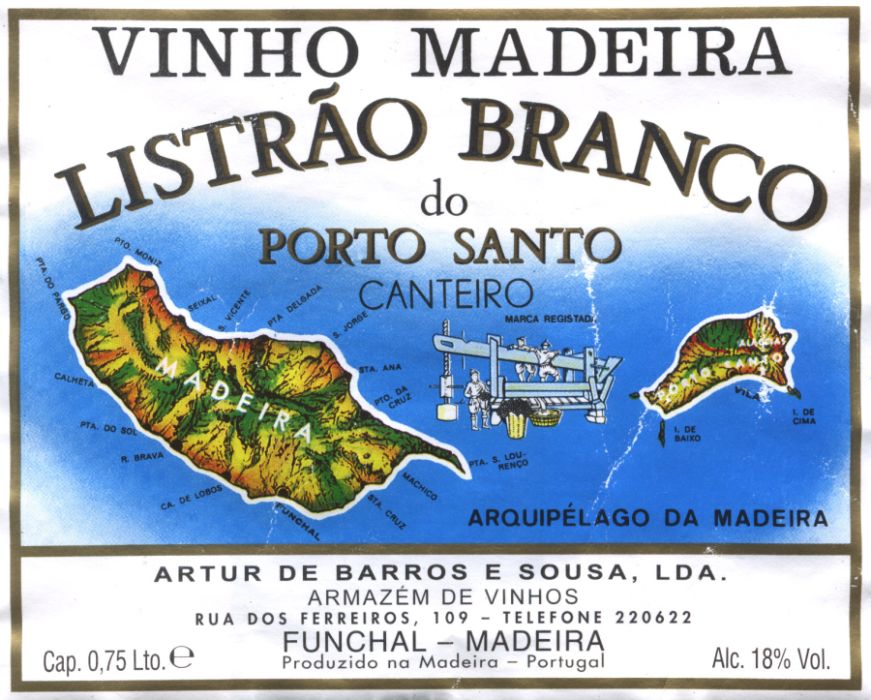
Label of ABSL Listrao
Old Wine
This does not name a grape variety but a vintage that does not consist of one single grape variety as the rules of the IVM say. This happens, when a year was good enough to declare it as a vintage but the yields of the different varieties were not enough to put them in cask and mature them at an affordable cost. In this case, as an example Bual and Malmsey will be matured together as "Old Wine" since the regulations don't know a Bual-Malmsey vintage. Sometimes Tinta might be added as well. Blends of different grape varieties are not uncommon anymore. The Alvada wine of the Madeira Wine Company is a blend of Malmsey and Boal. The Barbeito company has also made some wonderful blended wines from different grape varieties.
Tinta Negra Mole
Tinta is a red grape and is very versatile. Often called the working horse amongst the different varieties, it is one of the reasons for the decline of Madeira wine in the 19th and 20th century. It is counted among the Castas Boas, the good varieties. Tinta or TNM is grown around Funchal, São Vicente and Câmara de Lobos and is the most widely grown grape on the island. About 3/4 of the total production is Tinta. Depending on the height of the vineyard and the processing of the wine it can imitate the other varieties to a great degree. This makes Tinta so tempting for many producers, but the class of the other traditional varieties is said to be not fully reached by Tinta. The grape is a cross of Pinot Noir and Grenache. Some vineyards with Tinta are cleared today and replanted with other traditional vines, but it is still widely used, especially for the three year old blends.
However Tinta is not of low quality, as many good three, five and even some ten year old blends show. According to many wine professionals it simply does not quite reach the excellent quality of the other grapes. My personal belief is that it has great potential as long as it is well cared for. Some of the modern colheitas and harvest wines are made entirely of Tinta grapes and they show the great abilities of this grape very well. Also it has been added to vintage Madeira wines throughout the 19th and 20th century in small amounts up to 5 percent, since the wine made from TNM offered a certain neutrality that made it easy to add, without changing the original wines nose and palate. Since it is easy to grow, more wine of the medium qualities like older blends and the non-frasqueira vintage wines will be made from Tinta. I think we are going to be very surprised in the future about how good Tinta can really be.
The vine is robust with durable wood, medium size leaves and small black berries. The must is red at first but the estufagem procedure clears the color so that it acquires a green-white shine. Besides being used for blends, selected Tinta grapes from Campanário are also used for the Atlantis Rosé.
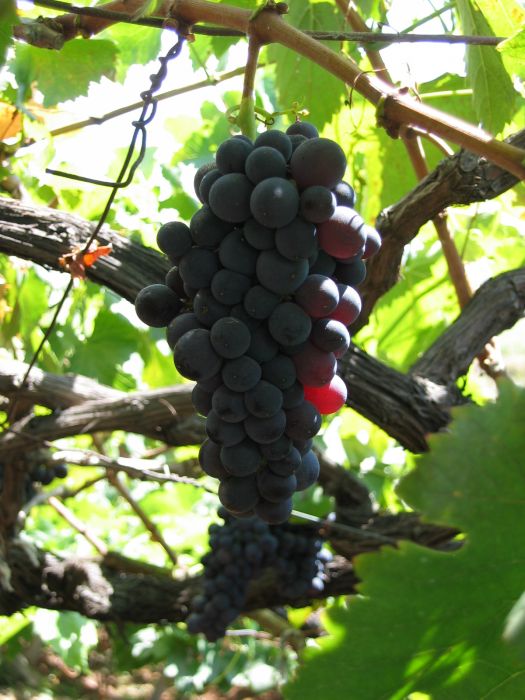
Tinta grapes seen at ABSL, shown with the friendly permission of Maik Göbel

You must be logged in to post a comment.